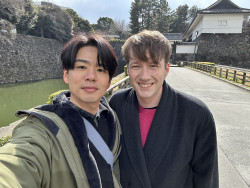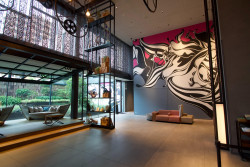
March 24, 2011
Koganecho
The former red-light district now hosts a new breed of performer
By Metropolis
Originally published on metropolis.co.jp on March 2011



 The sun drizzles gold across Yokohama’s Ooka River on a winter afternoon while a police officer helps a woman straighten the sign above her newly opened boutique. It’s a picture-perfect moment, suddenly shattered by an irritated grunt. I turn and see a middle-aged tourist standing next to me. Squinting at the idyllic scene, he shakes his head and snorts, “What the hell has happened to this town?”
The sun drizzles gold across Yokohama’s Ooka River on a winter afternoon while a police officer helps a woman straighten the sign above her newly opened boutique. It’s a picture-perfect moment, suddenly shattered by an irritated grunt. I turn and see a middle-aged tourist standing next to me. Squinting at the idyllic scene, he shakes his head and snorts, “What the hell has happened to this town?”
Until six years ago, the 400-meter stretch of river between Hinodecho and Koganecho stations was Japan’s largest illegal red-light district. In 200 tiny brothels, women from the world’s poorest countries sold sex in 15-minute bouts under the watchful eye of organized criminals. By 2005, the area had become so infamous that it was threatening to sully preparations for Yokohama’s 150th anniversary—so the authorities decided to act.
First, the police shut down the brothels. Then a loose-knit group of architects, university students and brave local residents set about transforming the district into a haven for artists. Now Koganecho is one of Japan’s most vibrant creative communities, with more than two dozen painters, photographers and designers living and working in the neighborhood.
I start explaining these changes to the tourist still standing beside me, but he’s lost in his memories. “You should have seen this place when I was last here in 2003. Thais, Cambodians, Colombians. The police ran raids then too—but the girls popped right back up. Trust me, they’re around here somewhere.”
Spotting one of the brothel’s red awnings, the tourist checks to make sure the policeman is distracted, then hurries toward the small building and peers inside. At a workbench, a young man puts the finishing touches to a bowl of origami fruit. The tourist presses his nose to the window of the next room and finds a woman weaving a tapestry with her foot. She offers the man a friendly wave. He recoils in disgust, but his eyes light up again when he sees a group of men gathered around a pretty young woman in a nearby doorway. He pushes to their front, only to discover that the focus of their negotiations is the best color for a stenciled cartoon character.
“Orange,” decides the woman, and the men voice their approval. Cursing the artists for ruining the neighborhood, the tourist reels down the narrow lanes, searching for the knocking-shops he’s convinced still exist.
I catch up with him outside a dilapidated two-story structure painted in gaudy pinks and blues. “This is more like it,” says the tourist to himself. Inside, he orders a beer and asks the proprietors about the building. When they tell him it used to be a hotel, he lowers his voice conspiratorially. “And what type of business are you in now?”
“We manage this café.”
Tipping them a knowing wink, he asks what they really do.
“To be honest, we’re guerrilla coffee artists.”
Seconds later, the tourist is back outside, checking his watch. In an hour, he’s due to meet his wife back at their Ginza hotel and the desperation on his face is clear. “I don’t even need a full 15 minutes. Ten would be more than enough.”
As though in reply, female flesh flickers in the darkness of the railway arches nearby. His perseverance seemingly vindicated, the tourist lets out a whoop. Following him to the source of his jubilation, I discover a projector set high in the wall streaming a video of a woman. She stoops and stretches, pretends to swim, then bails imaginary water from the ceiling.
The tourist takes the installation as a personal affront and he aims a kick at its base. The impact jars the video back to its beginning and the woman opens her mouth in silent laughter. His search a failure, the tourist storms away. “Why would anybody do something like this?”
He’s too far gone to hear, but I whisper an answer anyway: “Art.”
Trip Tips

Koganecho station is 25 minutes from Shinagawa on the Keikyu line. Alternatively, take a JR Keihin-Tohoku train to Sakuragicho station and follow the Ooka River upstream for 15 minutes.
Maki Takemoto’s tobio-chan stencils, the basis of an annual scavenger hunt, can be found in over 30 unlikely places throughout the area (http://meturl.com/makistencil). When not waging their caffeine-fueled jihad in vacant car parks and galleries across the Kanto Plain, artists L Pack have their home base in Ryugu Bijutsu Ryokan (http://meturl.com/lpack). Kentaro Taki’s video installation, “Invitation” plays from dusk to dawn beneath the Keikyu train tracks near Koganecho station (http://meturl.com/takiken).







